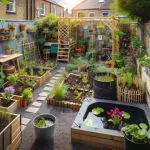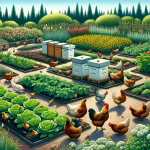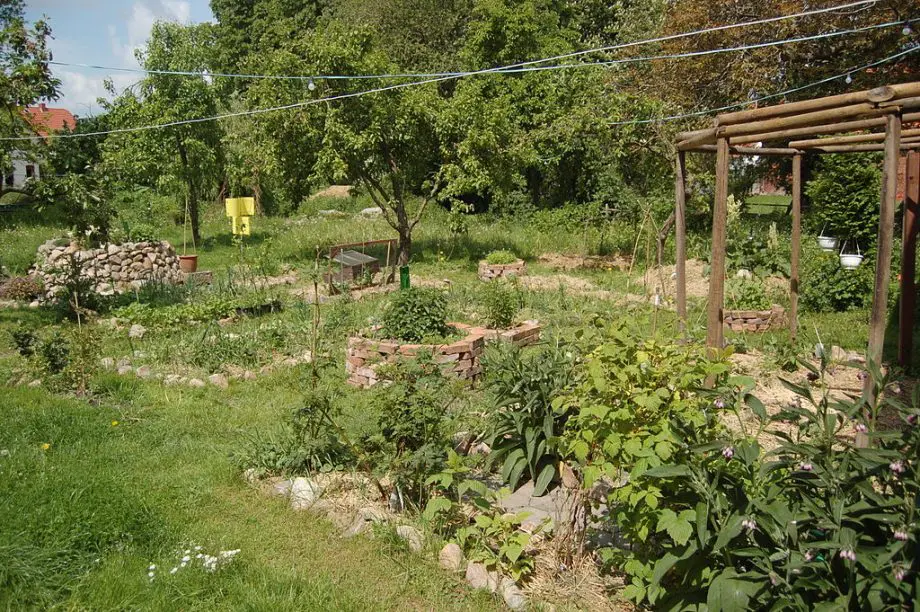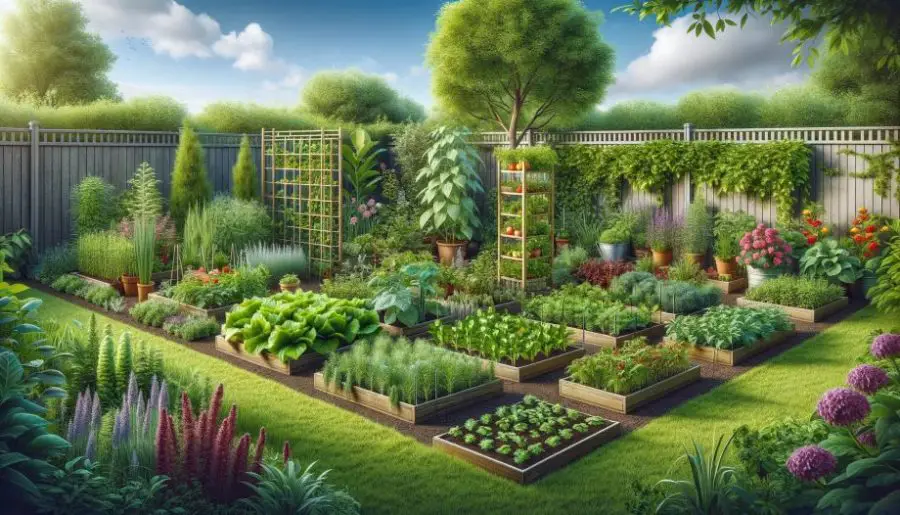
Discover how to start a permaculture garden in a small space with our easy guide! Transform your tiny area into a lush, eco-friendly oasis.
Small Permaculture Gardens Key Takeaways:
- Small permaculture gardens maximize limited space by using vertical planting, container gardening, and efficient design.
- They focus on biodiversity and sustainable practices, creating eco-friendly oases in urban settings.
Ever wondered how to start a permaculture garden in a small space? Well, you’re in luck!
Join us as we dive into the exciting world of urban permaculture, where we’ll show you how to turn even the tiniest spaces into flourishing, green havens. Let’s get growing!
Embracing Small-Space Permaculture Gardening
Permaculture, a fusion of ‘permanent’ and ‘agriculture,’ offers a sustainable approach to gardening, even in the smallest of spaces.
Whether you’re eyeing your balcony, a tiny yard, or a compact urban plot, starting a permaculture garden can transform these areas into thriving, eco-friendly oases.
This blog post will guide you through creating a vibrant permaculture garden, and adapting permaculture principles to small spaces.
We’ll cover everything from the initial layout and design to specific methods like Hugelkultur, ensuring your journey into permaculture gardening is both successful and enjoyable.
What is a Permaculture Garden?
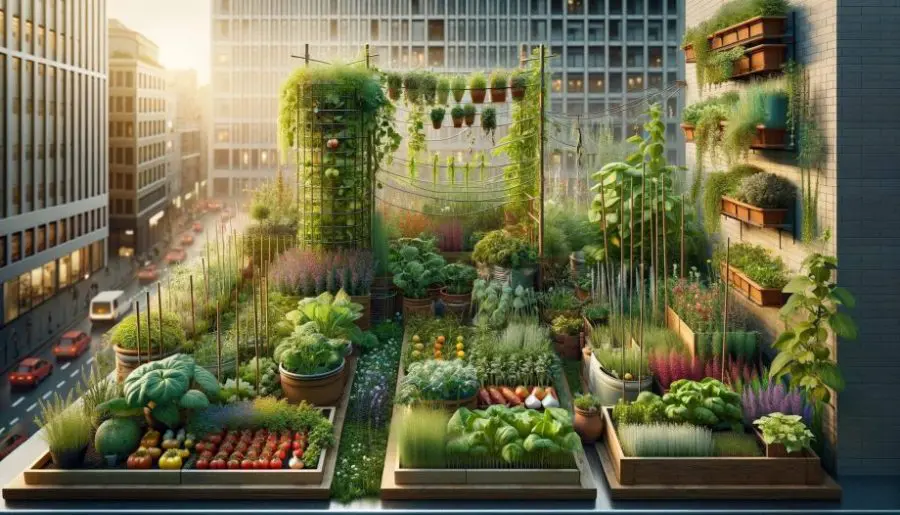
Dive into the world of permaculture gardens, where sustainability meets creativity.
In this section, we unravel the essence of ‘What is a Permaculture Garden?’
Exploring its holistic approach, we reveal how these gardens blend with nature, championing diversity, eco-friendliness, and ingenuity, even in the smallest of spaces.
Understanding the Concept
Permaculture gardens are more than just spaces for plant cultivation; they’re ecosystems designed for sustainability and efficiency.
Rooted in a philosophy that emphasizes harmony with nature, these gardens integrate elements like sun, wind, and water, turning them into allies.
This holistic approach creates spaces that are not only productive but also environmentally conscious.
Permaculture is an ecological design science drawing inspiration from natural ecosystems and permanent cultures from around the world. The term permaculture originated in Australia in 1978 – originally a combination of the words permanent & agriculture. It has since been expanded to mean permanent-culture and includes all aspects of what makes a human culture successful, from where we obtain food, fuel, fiber, medicine, energy, water, building materials and even expands into the connection between people and how we organize our social interactions and rely on one another. Western Michigan University
Key Characteristics
A permaculture garden, especially in a small space, thrives on the principles of diversity, sustainability, and resourcefulness.
Unlike conventional gardens with uniform layouts, permaculture gardens mimic natural ecosystems.
They feature a blend of native plants suited to the local climate, arranged in a way that maximizes space and resources. Key characteristics include:
- Diverse Planting: Encouraging biodiversity, permaculture gardens feature a mix of plant species that support each other.
- Sustainable Practices: These gardens prioritize sustainable, organic methods, minimizing waste and chemical use.
- Resource Efficiency: By utilizing natural resources like rainwater and promoting soil health through composting, these gardens aim for maximum efficiency.
- Adaptability: Permaculture gardens are adaptable to various environments, from small urban balconies to larger plots.
Integrating these characteristics into your small permaculture garden plan ensures not just a garden but a self-sustaining ecosystem.
Permaculture Benefits
Delve into the numerous benefits of permaculture gardening, where each plant and practice holds ecological significance.
This section highlights how permaculture, even in small spaces, not only enhances biodiversity and soil health but also fosters a sustainable future, creating a profound impact on both the environment and community.
Creating a permaculture garden, even in a limited space, offers numerous benefits:
- Environmental Impact: These gardens significantly reduce your carbon footprint by using organic practices and promoting biodiversity.
- Low Maintenance: Once established, permaculture gardens require less upkeep due to interdependent plant relationships.
- Enhanced Soil Health: The natural balance maintained in these gardens enriches the soil, fostering a healthier growing environment.
- Community and Wellness: They provide a sense of community and personal well-being, connecting gardeners with nature and neighbors alike.
How to Start Your Permaculture Garden in a Small Space
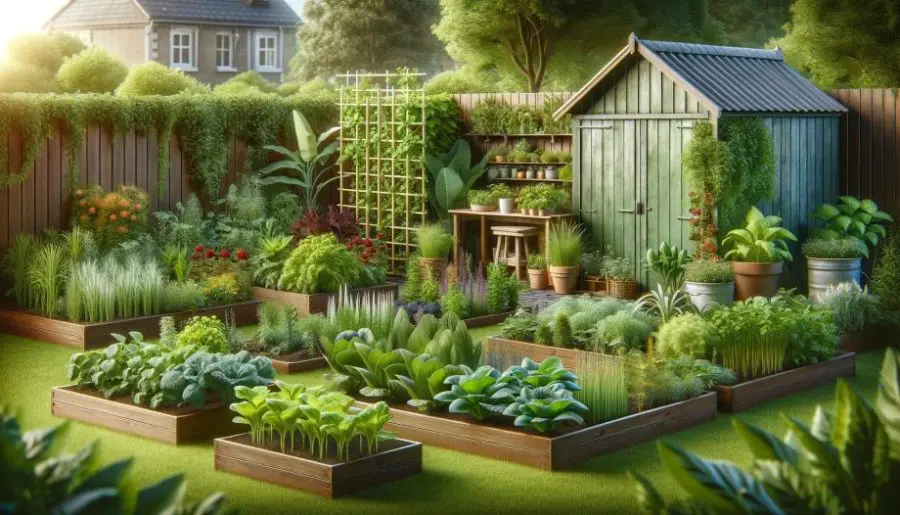
Ready to transform your small space into a green haven? Our guide on ‘How to Start Your Permaculture Garden in a Small Space’ offers practical steps to begin your journey.
From selecting the right spot to understanding your area’s unique traits, we’ll walk you through creating a thriving mini ecosystem.
Deciding the Location
The first step in creating your permaculture garden is choosing the right spot.
Even in small spaces, options like balconies, rooftops, or a section of your yard can become potential gardens.
The key is to observe your available space and its unique characteristics, such as sunlight exposure and soil type.
Observing and Preparing Your Space
Before planting, take time to understand your chosen area. Consider:
- Sunlight and Shade: Identify areas receiving the most sunlight and those shaded.
- Soil Quality: Assess the soil type and health. Is it rich in organic matter or does it require amending?
- Water Availability: Note the availability of water sources and any natural rainwater collection spots.
- Local Climate: Understanding your local climate helps in selecting plants that will thrive.
- Space Constraints: Consider the size and layout of your space. Even small areas can be maximized with creative design.
Once you’ve analyzed these elements, you’re ready to start shaping your garden, keeping in mind the principles of permaculture design.
Designing Your Garden
Embarking on the design phase of your small-space permaculture garden is a creative and strategic endeavor.
In ‘Designing Your Garden,’ we’ll delve into crafting an efficient layout that maximizes your area’s potential.
From plant selection to innovative space utilization, this section is your blueprint for a flourishing garden.
Designing a permaculture garden in a small space is an art. It involves:
- Zoning: Plan for different zones based on plant needs, sunlight, and water availability.
- Plant Selection: Choose a variety of plants that complement and support each other. Consider native species and those adapted to your climate.
- Layout: Utilize vertical space with trellises or hanging planters. Container gardening is also an effective way to manage space.
- Incorporating Sustainability: Plan for composting and rainwater harvesting within your design.
This thoughtful design process ensures your small permaculture garden is both functional and aesthetically pleasing.
Implementing Sustainable Practices
Stepping into the world of permaculture gardening means embracing sustainable practices at every turn.
In this section, we delve into how you can implement eco-friendly strategies in your small garden, from efficient water management to organic soil enhancement.
These practices not only benefit your garden but also contribute to a healthier planet.
In permaculture, sustainability is key. Implement practices such as:
- Composting: Convert organic waste into rich soil amendments.
- Water Management: Use rain barrels for water collection and drip irrigation for efficient watering.
- Soil Health: Enhance soil through natural amendments like compost, avoiding synthetic fertilizers.
- Pest Control: Employ natural pest control methods, fostering a balanced ecosystem.
These practices not only enrich your garden but also align with environmental stewardship.
Maximizing Small Spaces for Permaculture
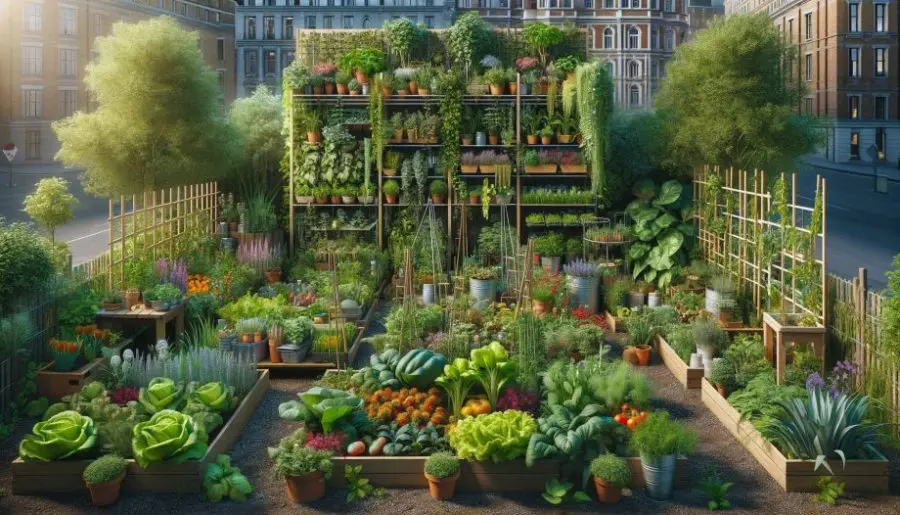
Maximizing small spaces is a key skill in permaculture gardening. In this section, we explore innovative ways to turn limited areas into lush, productive gardens.
Learn how vertical gardening, container planting, and thoughtful design can help you make the most of your space, creating a mini eco-paradise.
Creative Use of Limited Area
In small-space permaculture, creativity is your greatest asset.
Transforming limited areas into productive gardens requires innovative approaches, such as vertical gardening, container planting, and utilizing every inch of available space.
This section explores methods to turn even the tiniest spaces into flourishing permaculture gardens.
Techniques for Space Utilization
Utilizing space efficiently is vital in small permaculture gardens. This section delves into various techniques for space utilization, from vertical gardening to creative container use.
Discover how you can transform even the smallest areas into productive, green spaces, making every inch count in your permaculture journey.
Maximizing space in small permaculture gardens involves:
- Vertical Gardening: Use trellises, wall planters, or hanging baskets to grow upwards. Ideal for climbers like beans, peas, and certain types of squash.
- Container Gardening: Pots and containers offer flexibility. They can house a variety of plants, from herbs to small fruit trees.
- Layering: Mimic natural ecosystems by creating layers – tall plants like sunflowers can provide shade for lower-growing, shade-tolerant species.
- Balcony and Rooftop Gardening: Utilize balconies and rooftops by selecting appropriate container plants and ensuring adequate water and soil management.
Through these techniques, even a small balcony or rooftop can become a biodiverse permaculture garden.
Overcoming Challenges in Urban Settings
Urban settings pose unique challenges for permaculture gardens. In this section, we address how to navigate these obstacles, from dealing with soil limitations to adhering to urban regulations.
Learn effective strategies to cultivate a thriving permaculture garden in your urban space, turning challenges into opportunities for growth.
Urban permaculture gardening faces unique challenges, such as limited soil availability and potential restrictions.
Overcoming these involves:
- Soil Building: In areas with poor soil, use raised beds or containers filled with rich, organic soil.
- Dealing with Regulations: Check local regulations regarding gardening, especially in shared spaces like apartment balconies or rooftops.
- Pollution Management: In heavily urbanized areas, be mindful of air and soil pollution. Select plants that are more resilient and consider using barriers to protect your garden.
- Community Engagement: Leverage community gardens or shared spaces to expand your gardening possibilities and foster social connections.
Addressing these challenges ensures your small-scale permaculture garden thrives even in the heart of the city.
Permaculture Techniques and Methods
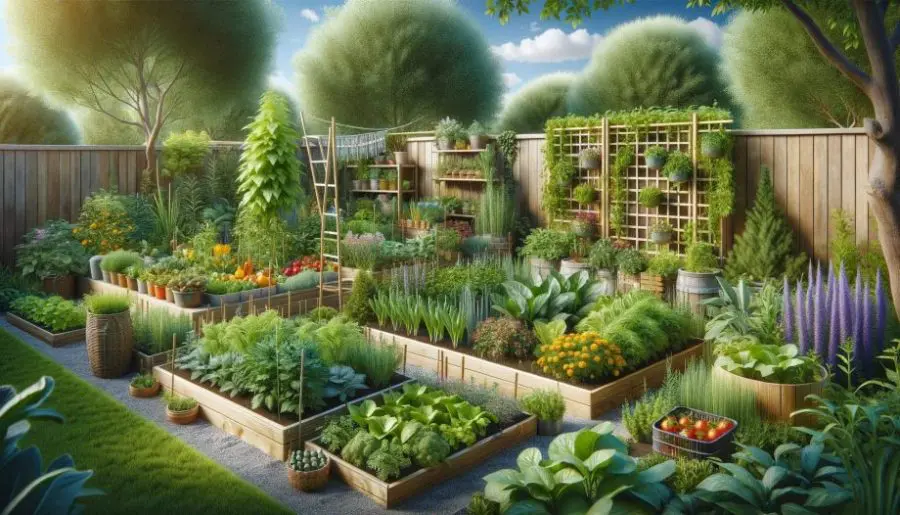
Permaculture is rich with diverse techniques and methods tailored for ecological harmony.
This section introduces you to various permaculture practices, perfect for small gardens.
From the intriguing Hugelkultur method to efficient bed preparation, these techniques are designed to enhance your garden’s productivity and sustainability.
Read more about the Hugelkultur Method: Ultimate Raised Bed Gardening – Sustainably Forward
Hugelkultur: Nature’s Raised Bed
Hugelkultur, a permaculture method, involves creating raised garden beds using decomposing wood and organic matter.
This technique is excellent for small spaces, offering enhanced soil fertility, improved water retention, and a natural way to recycle yard waste.
Here’s how you can implement Hugelkultur in your permaculture garden.
Implementing Hugelkultur in Small Spaces
Implementing Hugelkultur, an ingenious permaculture technique, can revolutionize gardening in small spaces.
In this section, we’ll explore how to adapt Hugelkultur to compact areas, creating raised beds rich in nutrients and moisture.
This method not only enriches your garden but also efficiently uses available space.
To create a Hugelkultur bed:
- Layering: Start with a base layer of logs and branches. Preferably use softwood for faster decomposition.
- Adding Organic Material: Cover the wood with layers of leaves, grass clippings, straw, and compost.
- Soil Topping: Add a layer of topsoil or garden soil.
- Planting: Plant directly into the mound. Hugelkultur beds are excellent for a variety of plants, from vegetables to herbs.
The benefits of Hugelkultur in small spaces include less frequent watering needs, improved soil fertility, and efficient use of vertical space.
Permaculture Bed Preparation
Preparing a permaculture bed in a small garden requires careful planning and soil preparation.
The goal is to create a nutrient-rich, well-draining bed that supports diverse plant life.
Here’s a step-by-step guide to preparing your permaculture bed, ensuring it’s ready to support a healthy and productive garden.
Steps for Permaculture Bed Preparation
To prepare a permaculture bed:
- Select the Location: Choose a spot based on sunlight, water availability, and ease of access.
- Soil Assessment: Test the soil for pH and nutrient levels. Amend the soil as needed with organic matter.
- No-Dig Approach: Avoid tilling to preserve soil structure. Layer compost, mulch, and organic matter on top of the soil.
- Define the Beds: Use natural materials like stones or wood to define the bed boundaries.
- Plant Selection: Choose a mix of plants that complement each other in terms of nutrient needs and growth patterns.
A well-prepared permaculture bed is the foundation of a successful garden, particularly in small spaces where efficient use of every inch is crucial.
Starting a Self-Sustaining Garden
Embarking on the creation of a self-sustaining garden embodies the true spirit of permaculture.
This segment guides you through establishing a garden ecosystem that largely maintains itself, even in smaller spaces.
We’ll cover the essentials of diverse planting, water management, and natural pest control to achieve sustainability.
Principles of a Self-Sustaining Garden
A self-sustaining garden is the epitome of permaculture, where the garden ecosystem largely maintains itself.
Achieving this in a small space involves careful planning and implementation of permaculture principles, ensuring that the garden’s needs for nutrients, water, and pest control are met naturally and sustainably.
Creating a Self-Sustaining Ecosystem
To develop a self-sustaining garden:
- Diverse Planting: Include a variety of plants to create a balanced ecosystem. Incorporate pollinators, nitrogen-fixers, and pest deterrents.
- Composting: Set up a compost system to recycle organic waste into nutrient-rich soil.
- Water Conservation: Use methods like rainwater harvesting and drip irrigation to minimize water usage.
- Natural Pest Control: Encourage beneficial insects and use companion planting to naturally control pests.
- Perennial Plants: Include perennials for long-term stability and reduced maintenance.
A self-sustaining garden not only minimizes labor and resource inputs but also creates a harmonious, resilient space that thrives year after year.
Permaculture Gardening in Small Spaces FAQs
Embarking on the journey of permaculture gardening, especially in smaller spaces, often brings a myriad of questions.
From the basics of starting your garden to the intricacies of specific techniques like Hugelkultur, it’s natural to seek guidance.
In this section, we delve into some of the most common queries about permaculture gardening in limited spaces.
These answers aim to provide you with practical insights and tips to help you create a flourishing, eco-friendly garden, no matter the size of your space.
Q: How do I start a small permaculture garden?
A: Starting a small permaculture garden involves selecting a suitable space, observing environmental factors like sunlight and soil quality.
Design the garden layout with permaculture principles, and choose appropriate plants.
Utilize vertical space and containers to maximize your limited area.
Q: How much space do you need for permaculture?
A: Permaculture can be adapted to almost any space, no matter how small.
Even balconies, rooftops, and tiny yards can be transformed into productive permaculture gardens using creative space utilization techniques like vertical gardening and container planting.
Q: How do I turn my yard into a permaculture garden?
A: Convert your yard into a permaculture garden by observing its unique characteristics.
Design a layout that mimics natural ecosystems, choosing a diverse range of suitable plants, and implementing sustainable practices like composting and rainwater harvesting.
Focus on creating a balanced, self-sustaining ecosystem.
Q: How do you start a permaculture bed?
A: To start a permaculture bed, choose a location, assess and prepare the soil using organic matter without tilling, define bed boundaries with natural materials, and select a mix of plants that support each other’s growth. Use a no-dig approach to maintain soil health.
Q: What is the Hugelkultur method?
A: Hugelkultur is a permaculture method where raised beds are created using layers of decomposing wood, organic matter, and soil.
It improves soil fertility, enhances water retention, and is particularly effective in small spaces for creating nutrient-rich, self-sustaining garden beds.
Q: How do I start a self-sustaining garden?
A: Start a self-sustaining garden by planting a variety of species that fulfill different roles, setting up a compost system, conserving water, encouraging natural pest control, and including perennial plants for long-term stability.
The goal is to create an ecosystem that requires minimal external inputs.
Conclusion: Cultivating Success in Small-Space Permaculture Gardening
As we wrap up our exploration of permaculture gardening in small spaces, it’s clear that the constraints of limited area don’t diminish the potential for creating a vibrant, sustainable garden.
With the right approach, even the smallest spaces can be transformed into productive ecosystems that contribute positively to the environment and our well-being.
Let’s revisit the key takeaways and consider the future possibilities for your small-space permaculture garden.
Embracing the Permaculture Philosophy
Permaculture is more than just a gardening technique; it’s a philosophy that integrates nature with our living spaces.
By adopting its principles, you’ve taken a step towards more sustainable living, contributing to environmental conservation and biodiversity.
Remember, every small permaculture garden is a vital part of a larger movement toward ecological mindfulness and resilience.
Continuous Learning and Adaptation
The journey of permaculture gardening is an ongoing learning process.
As you gain experience, you’ll discover new methods, plants, and designs that work best for your unique space.
Stay open to experimentation and adaptation, as the dynamic nature of ecosystems means that your garden will continue to evolve.
Community Engagement and Sharing Knowledge
Don’t forget the role of the community in permaculture. Share your experiences, learn from others, and maybe even inspire neighbors to start their own permaculture projects.
Engaging with a community of like-minded gardeners can provide valuable support and enrich your permaculture journey.
Looking Ahead: Expanding Your Permaculture Impact
As you grow in your permaculture practice, consider how you can expand your impact.
This could mean scaling up your garden, experimenting with new techniques, or even taking on community projects.
The skills and knowledge you’ve gained can have a broader impact, contributing to a more sustainable and environmentally conscious world.
Final Thoughts on Small Space Permaculture Gardening
In conclusion, starting a permaculture garden in a small space is not just about growing plants.
It’s about nurturing an ecosystem and being part of a global movement towards sustainability.
Your garden, no matter its size, is a testament to the fact that every effort counts in the journey towards a greener, more sustainable future.


